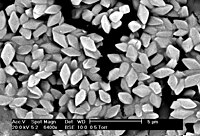
Ephestia kuehniella tolerance to Bacillus thuringiensis Cry1Aa is associated with reduced oligomer formation.
Sign Up to like & getrecommendations! Published in 2017 at "Biochemical and biophysical research communications"
DOI: 10.1016/j.bbrc.2016.11.115
Abstract: The basis of the different susceptibility of Ephestia kuehniella to the Cry1Aa and Cry1Ac δ-endotoxins from Bacillus thuringiensis kurstaki BNS3 was studied. Both toxins bound specifically to the BBMV of E. kuehniella. The result of the… read more here.
Keywords: cry1aa; ephestia kuehniella; cry1ac; reduced oligomer ... See more keywords

Expressing a moth abcc2 gene in transgenic Drosophila causes susceptibility to Bt Cry1Ac without requiring a cadherin-like protein receptor.
Sign Up to like & getrecommendations! Published in 2017 at "Insect biochemistry and molecular biology"
DOI: 10.1016/j.ibmb.2016.11.008
Abstract: Bt toxins ingested by insect pests can bind to midgut receptors and cause death, although several steps in this process remain unclear. Multiple Bt toxin receptors have been identified in Lepidoptera, including a cadherin-like protein… read more here.
Keywords: protein; like protein; cadherin like; cry1ac ... See more keywords

FOXA transcriptional factor modulates insect susceptibility to Bacillus thuringiensis Cry1Ac toxin by regulating the expression of toxin-receptor ABCC2 and ABCC3 genes.
Sign Up to like & getrecommendations! Published in 2017 at "Insect biochemistry and molecular biology"
DOI: 10.1016/j.ibmb.2017.07.004
Abstract: Cry toxins produced by Bacillus thuringiensis (Bt) are insecticidal proteins widely used in insect control. Recently, it was shown that ATP-binding cassette transporter proteins (ABC) such as ABCC2, ABCC3, ABCG1 and ABCA2 are implicated in… read more here.
Keywords: toxin; cry1ac; expression; abcc2 abcc3 ... See more keywords

A single amino acid polymorphism in ABCC2 loop 1 is responsible for differential toxicity of Bacillus thuringiensis Cry1Ac toxin in different Spodoptera (Noctuidae) species.
Sign Up to like & getrecommendations! Published in 2018 at "Insect biochemistry and molecular biology"
DOI: 10.1016/j.ibmb.2018.06.004
Abstract: Bacillus thuringiensis Cry toxins exert their toxicity by forming membrane pores after binding with larval midgut membrane proteins known as receptors. Spodoptera litura and Spodoptera frugiperda belong to the same genus, but S. litura is… read more here.
Keywords: amino acid; cells expressing; cry1ac; differential toxicity ... See more keywords

CRISPR/Cas9-mediated knockout of both the PxABCC2 and PxABCC3 genes confers high-level resistance to Bacillus thuringiensis Cry1Ac toxin in the diamondback moth, Plutella xylostella (L.).
Sign Up to like & getrecommendations! Published in 2019 at "Insect biochemistry and molecular biology"
DOI: 10.1016/j.ibmb.2019.01.009
Abstract: Rapid evolution of resistance by insect pests severely jeopardizes the sustainable utilization of biopesticides and transgenic crops that produce insecticidal crystal proteins derived from the entomopathogenic bacterium Bacillus thuringiensis (Bt). Recently, high levels of resistance… read more here.
Keywords: crispr cas9; pxabcc2 pxabcc3; cry1ac; resistance ... See more keywords

Bt Cry1Ac resistance in Trichoplusia ni is conferred by multi-gene mutations.
Sign Up to like & getrecommendations! Published in 2021 at "Insect biochemistry and molecular biology"
DOI: 10.1016/j.ibmb.2021.103678
Abstract: The three-domain Cry toxin Cry1Ac from Bacillus thuringiensis (Bt) is an important insecticidal toxin in Bt sprays and has been used in transgenic Bt-crops to confer insect resistance. The cabbage looper, Trichoplusia ni, has developed… read more here.
Keywords: apn1 apn6; cry1ac; resistance; cry1ac resistance ... See more keywords

Differential heliothine susceptibility to Cry1Ac associated with gut proteolytic activity.
Sign Up to like & getrecommendations! Published in 2019 at "Pesticide biochemistry and physiology"
DOI: 10.1016/j.pestbp.2018.10.001
Abstract: The Cry1Ac protein is the most active insecticidal toxin from the bacterium Bacillus thuringiensis (Bt) to members of the heliothinae subfamily in Lepidoptera, which includes some of the most devastating pests of corn and cotton… read more here.
Keywords: digestive fluids; heliothine; activity; cry1ac ... See more keywords

Knockdown of the aminopeptidase N genes decreases susceptibility of Chilo suppressalis larvae to Cry1Ab/Cry1Ac and Cry1Ca.
Sign Up to like & getrecommendations! Published in 2020 at "Pesticide biochemistry and physiology"
DOI: 10.1016/j.pestbp.2019.08.003
Abstract: Bacillus thuringiensis (Bt) insecticide is currently the most widely used bioinsecticide. Bt expressing cry genes are some of the most successful foreign-genome-inserting genes used in transgenic insect-resistant crop development. Cry toxins are resistant to lepidopteran… read more here.
Keywords: suppressalis larvae; cry1ab; aminopeptidase genes; cry1ca ... See more keywords

MAP4K4 controlled transcription factor POUM1 regulates PxABCG1 expression influencing Cry1Ac resistance in Plutella xylostella (L.).
Sign Up to like & getrecommendations! Published in 2022 at "Pesticide biochemistry and physiology"
DOI: 10.1016/j.pestbp.2022.105053
Abstract: Deciphering the molecular mechanisms of insect resistance to Bacillus thuringiensis (Bt) based biotechnology products including Bt sprays and Bt crops is critical for the long-term application of Bt technology. Previously, we established that down-regulation of… read more here.
Keywords: poum1; expression; cry1ac; pxabcg1 expression ... See more keywords

ATP Synthase Subunit α from Helicoverpa armigera Acts as a Receptor of Bacillus thuringiensis Cry1Ac and Synergizes Cry1Ac Toxicity.
Sign Up to like & getrecommendations! Published in 2023 at "Journal of agricultural and food chemistry"
DOI: 10.1021/acs.jafc.3c00259
Abstract: Insect resistance to Bacillus thuringiensis (Bt) toxins has led to an urgent need to explore the insecticidal mechanisms of Bt. Previous studies indicated that Helicoverpa armigera ATP synthase subunit α (HaATPs-α) is involved in Cry1Ac… read more here.
Keywords: bacillus thuringiensis; cry1ac toxicity; cry1ac; haatps ... See more keywords

Aminopeptidase N1 is involved in Bacillus thuringiensis Cry1Ac toxicity in the beet armyworm, Spodoptera exigua
Sign Up to like & getrecommendations! Published in 2017 at "Scientific Reports"
DOI: 10.1038/srep45007
Abstract: Understanding how insecticidal proteins from the bacterium Bacillus thuringiensis (Bt) interact with their hosts is crucial to fully explain the molecular bases of Bt specificity and insecticidal activity. Previous studies support ATP binding cassette transporters… read more here.
Keywords: cry1ac toxicity; armyworm spodoptera; cry1ac; spodoptera exigua ... See more keywords